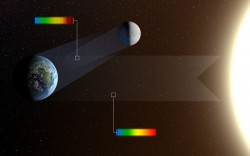[/caption]
It may seem like a silly question — of course there’s life on Earth — but what if we didn’t know that? What if we were looking at Earth from another vantage point, from another planet in another star system, perhaps? Would we be able to discern then if Earth were in fact teeming with life? All we’d have to go on would be the tiniest bit of light reflected off Earth, nearly lost in the intense glare of the Sun.
Researchers have found that the secret is knowing what kind of light to look for. And they discovered this with a little help from the Moon.

By using Earthshine — sunlight light reflected off Earth onto the Moon — astronomers with the European Southern Observatory have been able to discern variations that correlate with identifying factors of our planet as being a happy home for life.
In observations made with ESO’s Very Large Telescope (VLT), the presence of oceans, clouds, atmospheric gases and even plants could be detected in the reflected Earthshine.
The breakthrough method was the use of spectropolarimetry, which measures polarized light reflected from Earth. Like polarized sunglasses are able to filter out reflected glare to allow you to see clearer, spectropolarimetry can focus on light reflected off a planet, allowing scientists to more clearly identify important biological signatures.
“The light from a distant exoplanet is overwhelmed by the glare of the host star, so it’s very difficult to analyze — a bit like trying to study a grain of dust beside a powerful light bulb,” said Stefano Bagnulo of the Armagh Observatory, Northern Ireland, and co-author of the study. “But the light reflected by a planet is polarized, while the light from the host star is not. So polarimetric techniques help us to pick out the faint reflected light of an exoplanet from the dazzling starlight.”
Since we have fairly reliable proof that life does in fact exist on Earth, this provides astronomers with a process and a benchmark for locating evidence of life on other distant worlds — life as we know it, anyway.
Read more on the ESO website here.
Main image credit: ESO/B. Tafreshi/TWAN (twanight.org). This research was presented in a paper, “Biosignatures as revealed by spectropolarimetry of Earthshine”, by M. Sterzik et al. to appear in the journal Nature on 1st March 2012. The team is composed of Michael F. Sterzik (ESO, Chile), Stefano Bagnulo (Armagh Observatory, Northern Ireland, UK) and Enric Palle (Instituto de Astrofisica de Canarias, Tenerife, Spain).


At least on the weekends there is life.
This is a synthesis, I think. Looking at absorption has been done before (and IIRC the red edge of plants was detected). Polarization has been suggested (oceans, clouds et cetera).
The next step may be to look at the wavefront. IIRC the scattering of regular structures such as continental wide forests is believed to show up there.
Is it the reflected green light from vegetation they look for?
I seem to remember reading somewhere that plants on our world reflect green light because they absorb red and blue light, which in turn they do because the Sun outputs those colours with more intensity than green light. On another world, where the parent star peaks in other wavelengths, the native plant-life might find a configuration of chlorophyll (or some other molecule) that takes advantage of that, resulting in a different outward appearance (blue forests!)
I only dimly remember this though, so is any of it right?
The sun has the maximum output in green light at approx 5020Å (According to Wikipedia , Wien’s displacement law and a 5778K hot sun gives 5020Å peak)
Why plants evolved to reflect the maximum energetic part of the solar spectrum, while absorbing the wavelenghts relatively close to the maximum? I dont know.
But i am with you that this may not be necessary, and that plants in another system probably can evolve a different mechanism.
Good questions.
It doesn’t come out in this article, but in a way they look for “green”. It is the polarization from chiral (metabolically produced) chlorophyll that they detect. Apparently they have done two passes to check on the method, and they can see ~ 50 – 70 % clouds (which would vary), ~ 30 – 50 % oceans and ~ 3 – 7 % “forests” (both of which would be obscured by clouds).
Not too bad!
People have been proposing similarly, and I think already detected, the “red edge” of plant life IR absorption in the reflected light. But polarization bumps the sensitivity.
The light absorption of photosynthesis is still an open field. The antenna complexes of plants capture many photons of diverse energy and couples them efficiently, apparently by quantum mechanical mechanisms, to the absorbing pigments.
The pigments in modern plants are used in two consecutive chains, one that collects a few higher energy bluish photons and one that collects more lower energy reddish photons, to produce as much energetic energy transfer molecules as possible.
If these antenna complexes would be using photons narrowly around the maximum influx*, they would produce less energy. By positioning the capture on both sides, they maximize energy production.
Note that as always such natural selection results (if that is what they are, still not verified I believe) are contingent. Plants in particular squander their meticulously captured energy by using an early, pre-oxygen atmosphere enzyme (RuBisCo) that is poisoned by the very oxygen that plants release. It looses energy and has to be recycled frequently, another energy loss. The enzyme is so ineffective that it is the most common protein of all.
Yes, there will be other solutions elsewhere. Green plants would be rare, but not especially so.
—————–
* The atmosphere modifies that, but I can’t remember how. For this principle discussion, we can take “the visible window” as uniform transmission.
Fascinating!
Oooooh… perhaps with such chromatic freedom, the colour of plants would be more easily (and at an earlier stage of evolution) influenced by other organisms!
Ah yes, one of my first Universe Today articles: http://www.universetoday.com/85038/red-suns-and-black-trees-shedding-a-new-light-on-alien-plants/
Interesting and meani9ngful too, Actually before reading this post carefully people find him or herself stumble. I truly appreciate your exposed, I mean whatever you want to say here its impressive. Thanks!